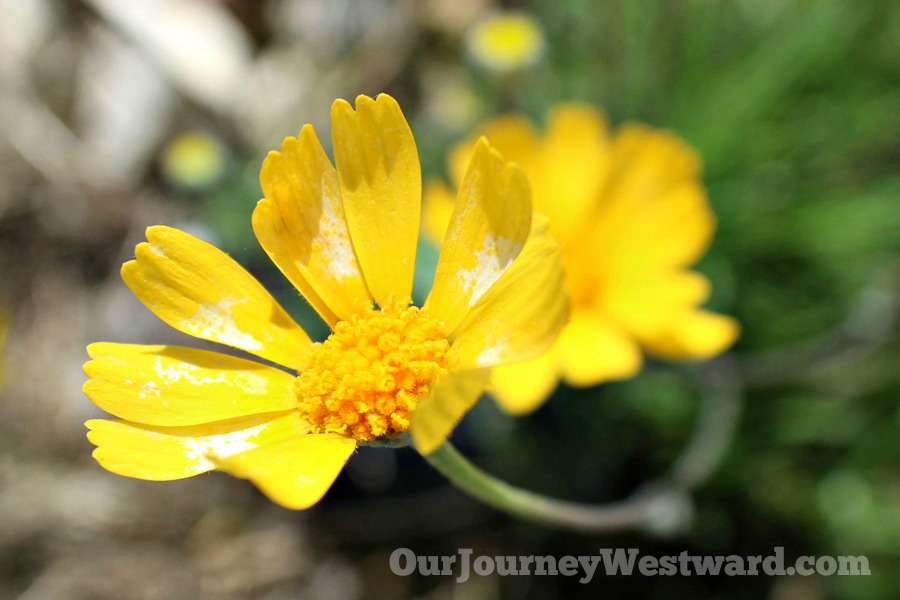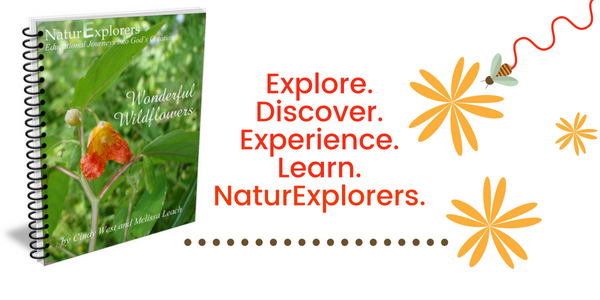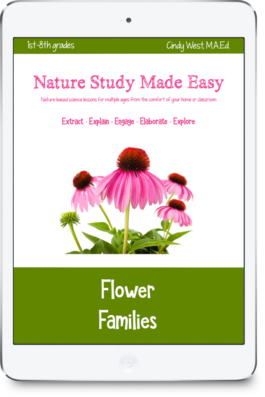How To Teach an Interest-Based Nature Study with NaturExplorers
It’s time for another peek into the real-life study of nature! In this post, you’ll see how easily Amber Oliver and her children could explore and discover wildflowers through an interest-based nature study.
I believe in occasionally letting our children have a say in their schooling. It’s highly motivating for them to make decisions and helps them take real ownership of the learning.
Besides allowing her children to participate in planning which wildflower activities their family would complete, Amber was also great at incorporating lessons that supported their passions and learning styles. Again, this promotes excitement in the learning process.
You’ll notice that Amber mentions she used NaturExplorers to help reconnect her tech-savvy kids to the outdoors. The topic of wildflowers is a perfect way to do that spring through autumn. Wildflowers are not only abundant and easy to find, but they are also incredibly more interesting than you might imagine. (Even Amber’s son thinks so!)

This post contains affiliate links.
Interest-Based Nature Study
I’ve spent most of my life in the rural areas of north-central Texas, surrounded by a varied and colorful display of wildflowers from early March through the end of June. Growing up, my favorites were the Indian paintbrushes and our beloved Texas bluebonnet. Though each spring greeted us with more than these bright beauties, I only had eyes for my two favorites.
Until I had kids, I didn’t even realize there was a cycle and order to the wildflower season. The paintbrushes come and go, and before the bluebonnets are gone, the delicate-pink evening primrose takes the stage. Before long, the Indian blanket bursts forth in a fiery blaze, a prelude for the hot summer months to come.

One of the things I love about Texas is that the highways are lined with wildflowers all season because they don’t mow them down but let them grow. It’s a glorious display of God’s beauty.
Raising Curious Little Nature Explorers
When the kids were little, we naturally spent much time outside. They loved being outdoors; the Texas spring air always kept us away from our books. We have a living landscape to explore at our leisure. The fields around us are ripe with purple coneflower, various types of daisies and sunflowers, yucca, and milkweed–to name a handful.

When the kids caught their first caterpillar, we learned that butterflies and moths have specific wildflower host plants. When we found our first butterfly cocoon on a tree in our yard, we learned what a hackberry tree is–and later, what a hackberry emperor butterfly looks like. Through observation and exploration, we also learned about a great many other plants and bugs. As we’ve observed and learned, we’ve seen God’s hand at work in His creation.
The easiest way to learn about nature is to be in it. And the best thing about being in nature is seeing God in it.
Encouraging Nature Study for Older Kids
Recently, I realized my kids haven’t spent as much time outdoors as they used to. I also realized that the last time we did a flower study and dissection, my now 12-year-old son was a toddler. He’s never done a flower dissection, and he only remembers the days when he caught beetles and fireflies in jars to observe.
I wanted to reconnect my tech-savvy kids with nature to help them see its beauty and intelligent design in a way they could enjoy, relate to, and remember.
Fortunately, I know a lot about my kids and their interests. Armed with this “insider secret” information and a copy of Wonderful Wildflowers, I knew how to get them outside and into the wildflowers.
A Science-Based Wildflower Nature Study
My almost-teen-boy isn’t very interested in flowers, but he IS interested in science. Wildflowers are FULL of science to be learned. He just needed to see wildflowers as something that could be examined, dissected, and studied.
Before beginning our wildflower study, I printed off the entire NaturExplorers Wonderful Wildflowers guide to look at. Together, the kids and I read over the reasons for studying nature, and the background information about wildflowers. We read about the difference between native wildflowers and native cultivated plants, about the science of flower reproduction, and we examined the chart of flower parts.
Interest-Based Nature Study Activities
After that introduction, we went through the study and chose the different activities we wanted. Our first activity was a simple data collection. I sent my son out across the property to collect samples of all the different types of flowers he could find, and my daughter was sent out to take pictures of the different flowers my son collected.
When they returned, we tried to identify the flowers they found and organized them onto a posterboard for display. On this first excursion, my son found eight different types of flowers, and we identified about half of them.

One of the suggested activities was a flower dissection; we wanted to do that. Letting my son take the lead (and the exacto knife), I let him cut open a few flowers. He looked at them under the magnifying glass, under a flashlight, and on the illuminated lightboard. I even let him have a leaf and a bloom from my indoor peace lily so he could compare. He dissected and examined for as long as he wanted before we called it a day.
Studying Wildflowers Through Photography
My 15-year-old daughter is really into photography. I wanted to include her, too, but in a way that gave her a level of responsibility and independence, so I made her the official photographer of our nature study.
Our third wildflower activity was visiting a small native plant botanical garden (wildflowers and cultivated). As mentioned in the unit study, “getting into nature” doesn’t have to mean “wild nature.” This botanical garden is a nice little city park, organized into sections with name plates for the different types of flowers.
As we walked through the native flower garden, we not only recognized many of the plants we saw but also learned the names of the different flowers we recognized.

We also witnessed many animal activities: birds, bees, butterflies, and even a little field mouse. All the while, my daughter took pictures of everything. Through the camera lens, she focused on the subject of our study.
The kids enjoyed the botanical garden, with its trails, sidewalks, signs, and borders. Sometimes, nature is wild and untamed, but sometimes, it’s orderly and structured.

Researching State Wildflowers In Reference Books
With a quick trip to our local library, my daughter and I were able to select three reference books to guide us on the rest of our journey. We found a copy of what is possibly the best Texas wildflower field guide (Wildflowers of Texas by Geyata Ajilvsi), a second wildflower guide with beautifully illustrated pictures, and a book of wildflower legends and lore (which turned out to be a real gem!)

Our fourth wildflower activity was a simple perusal through the wildflower field guide. My son and I took a virtual stroll through the flowers, page by page, looking for flowers we recognized and had seen in our area.
We found flowers that grow on our property and flowers that we don’t have, but we’ve seen in other parts of the county. It was fun to watch my son excitedly say, “Oh! We have that one!” It was also good to “put names to faces,” so to speak.
Our local library is one of my favorite indoor ways to study nature. Of course, Mrs. Cindy’s lessons in No Sweat Nature Study are a favorite, too!
Wildflower Field Guides
A Wildflower Hunt
After looking through the reference books with my son, we set out on a second property tour, this time together. I was curious to see how many different types of flowers he would find now that he was paying more attention.

With fresh images of native wildflowers, we walked the property, keeping a keen eye out for big and small flowers. We carried along my cell phone, taking pictures of everything we found.
This time we found 18 different varieties of wildflowers!
We remembered most of the flowers that we saw, but there were many that we didn’t. When we returned inside, we sat down with our field guide and pictures to identify the new ones. I have always wondered about our fancy little purple flowers, which we now know are called purple prairie clover.
There are still so many wildflower varieties that have yet to appear for the season, and we will have to go on another wildflower hunt soon!

Wildflower Stories and Wildflower Art
Our final wildflower project (for now) was a fun one! I asked my son to choose ANY wildflower to draw for me. He chose the Indian blanket – a great choice, with many bright colors to interest the eye. Drawing flowers (one of the activities we chose from the NaturExplorers guide) is a good way to learn and remember the details of the flowers you are studying.

While he sketched a work of art for me, I read stories from Legends and Lore of Texas Wildflowers. We learned that the Indian blanket has a few different legends attached to it. The sweetest one was the tale of a young Indian girl who got lost in the woods and awoke to a covering of flowers that resembled the bright colors of her father’s favorite blanket.
One of the really cool things about this book is the additional information about each flower, such as medicinal uses or their symbiotic relationship with specific insects. We learned, too, about the unique relationship between the yucca plant and the female yucca moth. The moth intentionally takes pollen from the male anther of one yucca plant and intentionally fertilizes the female stigma on another plant. She lays her eggs on the flower’s pistil, which develops along with the flower’s seeds. The caterpillars will feed on them when they hatch. It makes me want to pay special attention to them next year!
Wildflower Study Never Ends
I’ve noticed that once you create a spark of interest, it’s hard to put it out. My kids might not grow up to be botanists. Still, once they learn the names and colors of the various wildflowers, their relationships with various insects, and their common uses, they will always see those flowers differently. The NatureExplorers Wonderful Wildflowers Study is just the beginning of a long-term study of the flowers around us!
We have never forgotten that hackberry trees are the host plant for hackberry moths or that monarch butterflies need milkweed. We’ve learned that we could harvest the dandelions from our yard for tea and jelly or the purple coneflowers (echinacea) for several different uses. And we’ve discovered that clover comes in several types and colors (not only the green clover with the little yellow flowers.)
As we enjoy the rest of our wildflower season here in Texas, we’ll see new flowers come along, and CURIOSITY will want to know their names. We’ll look them up online and see what they are called. Our Texas wildflower fun will continue by spending more time outside this spring and summer.

Amber Oliver is a relaxed homeschool mom who believes that learning happens all the time and that the school day doesn’t need to begin before 10 am and two cups of coffee. She has been homeschooling since 2003 and writing about it since 2006. Amber has one homeschool graduate, with one high-schooler and one middle-schooler still at home. More than anything else, Amber’s biggest homeschool goal is to raise children who can see God everywhere in the world around them so that they might know him deeply and intimately. You can find Amber at ClassicHousewife, on Facebook, and on Instagram.
Products you may like:
-
Flower Families$18.00
-
-
Wonderful Wildflowers$22.00












I have just begun learning about Charlotte Mason homeschooling and this looks like the perfect resource for nature study! Hope you’ll share this and more at the #LovetoLearn blog hop ~Natural Parent Guide
I purchased the Frog and Toads Natur Explorer but I wait to do this one in the Spring, right?